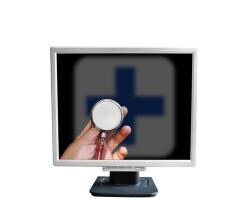 There are few worse places to wait in line than in a doctor’s office or urgent care clinic, surrounded by coughers and sneezers and nose-blowers.
There are few worse places to wait in line than in a doctor’s office or urgent care clinic, surrounded by coughers and sneezers and nose-blowers.
 There are few worse places to wait in line than in a doctor’s office or urgent care clinic, surrounded by coughers and sneezers and nose-blowers.
There are few worse places to wait in line than in a doctor’s office or urgent care clinic, surrounded by coughers and sneezers and nose-blowers.
That’s why QLess, a tech company that works with service providers to manage their waiting lines virtually, is ramping up its efforts in the healthcare industry. Since the average patient waits about 20 minutes in a doctor’s office waiting room, it seems like a likely fit.
Providers run QLess on a computer or kiosk set up in the waiting room. Patients secure their place in line by entering their cell phone numbers into the system upon arrival and choosing what kind of mobile alerts they’d like to receive. QLess tells them how long the wait is and pushes periodic updates of wait times to the patient, including a final notification when it’s almost their turn. If users need more time, they can push back their place in line.
Software and internet entrepreneur Alex Backer founded QLess back in 2007, after a long wait in line triggered him to think there had to be a better way. He formed the company with the idea that it would be used in restaurants, theme parks and voting stations. But it’s naturally grown into healthcare, too, in urgent care centers and doctor’s offices.
Backer said one of the keys to adoption has been its ease of use. Administrators can manage the queue from their computers, and individual users don’t need to download any kind of app. “Initially, they don’t know that the provider has it, though. They’ll find out through a tablet at the doctor’s office or a receptionist,” Backer noted. “”So there’s an adoption curve in terms of taking full advantage of it.”
Another feature that’s been especially valuable for expanding in the healthcare market is the analytics component that captures customer metrics. “We give them a dashboard that says everything from how long do patients have to wait to how many patients they lose during the wait to average return rates,” Backer said. There’s also an online scheduling component that allows patients to schedule appointments, or primary care physicians to view a specialist’s schedule and make appointments for patients at the point of care.
QLess is a standalone product — it doesn’t integrate with other online scheduling software. But Backer said that hasn’t been a problem because in most waiting rooms right now are still very low-tech. “It’s technologizing an experience that right now is not high-tech,” he said.
A number of other startups are working on that, too. ZappRX is targeting long waits at pharmacies, and InQuicker does online queues for ERs and physician waiting rooms, for example. According to Boston.com, QLess last week acquired Textaurant Corp., which makes similar technology used by Boston-area restaurants.
Originally published on MedCityNews.com.
[Photo from Flickr user Jeff Kramer]








